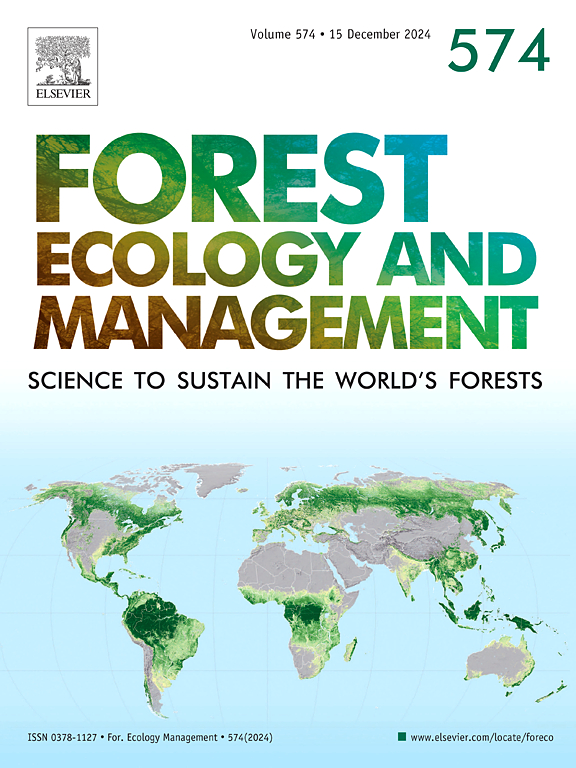Divergent growth responses and future projections of Larix sibirica and Picea schrenkiana to extreme climate events at the Eastern Tianshan timberline
IF 3.7
2区 农林科学
Q1 FORESTRY
引用次数: 0
Abstract
The timberline is a sensitive indicator of the health of alpine ecosystems. Forests in these ecosystems have been substantially affected by the increasing intensity of extreme climatic events and this trend is projected to escalate during the 21st century. However, the influence of extreme climatic events on tree growth remains poorly understood. In this study, we used Larix sibirica and Picea schrenkiana from the eastern Tianshan timberline to investigate the radial growth responses of these two species to extreme climatic events and predict growth trends under future climate scenarios. Our analysis of 1961–2009 climate data showed accelerated warming, particularly in extreme warm nighttime events (TN90P). The Iranian and western Pacific subtropical high-pressure systems may be key regulators of the variability of TN90P in the study area. The tree-ring chronologies of both species were positively correlated with extreme warm temperature indices and exhibited a weaker response to extreme precipitation. Larix sibirica growth was strongly correlated with extreme warm daytime events (r = 0.495, p < 0.01), whereas Picea schrenkiana primarily responded TN90P to (r = 0.640, p < 0.01). Lasso regression models incorporating CMIP6 climate projections predicted that both species would show an increase in growth, especially in SSP5–8.5. However, Larix sibirica (SSP2–4.5= 0.007/a; SSP5–8.5= 0.019/a) had a substantially greater growth trend than Picea schrenkiana (SSP2–4.5= 0.003/a; SSP5–8.5= 0.009/a). These findings highlight the emergence of day and nighttime warming events and species specificity as drivers of tree growth divergence in high-altitude ecosystems. They provide critical insights for predicting alpine forest dynamics under escalating climate extremes.
东天山林线西伯利亚落叶松和雪山云杉生长对极端气候事件的差异响应及未来预测
树带界线是高山生态系统健康状况的敏感指标。这些生态系统中的森林已受到日益严重的极端气候事件的严重影响,预计这一趋势将在21世纪升级。然而,极端气候事件对树木生长的影响仍然知之甚少。本文以天山东部林带线的西伯利亚落叶松(Larix sibirica)和雪山云杉(Picea schrenkiana)为研究对象,研究了这两种树种对极端气候事件的径向生长响应,并预测了未来气候情景下的生长趋势。我们对1961-2009年气候数据的分析显示,气候变暖加速,特别是在极端温暖的夜间事件(TN90P)中。伊朗和西太平洋副热带高压系统可能是研究区TN90P变率的关键调节因子。两种树种的年轮年表均与极端温暖温度指数呈正相关,对极端降水的响应较弱。西伯利亚落叶松(Larix sibirica)的生长与极端暖日事件有较强的相关性(r = 0.495,p <; 0.01),而雪杉(Picea schrenkiana)主要对TN90P有响应(r = 0.640,p <; 0.01)。结合CMIP6气候预估的Lasso回归模型预测,这两个物种的生长都将增加,特别是在SSP5-8.5。西伯利亚落叶松(SSP2-4.5 = 0.007/a;SSP5-8.5 = 0.019/a)的生长趋势明显大于云杉(SSP2-4.5 = 0.003/a;ssp5 - 8.5 = 0.009 / a)。这些发现强调了白天和夜间变暖事件的出现以及物种特异性是高海拔生态系统中树木生长分化的驱动因素。它们为预测极端气候升级下的高山森林动态提供了重要见解。
本文章由计算机程序翻译,如有差异,请以英文原文为准。
求助全文
约1分钟内获得全文
求助全文
来源期刊

Forest Ecology and Management
农林科学-林学
CiteScore
7.50
自引率
10.80%
发文量
665
审稿时长
39 days
期刊介绍:
Forest Ecology and Management publishes scientific articles linking forest ecology with forest management, focusing on the application of biological, ecological and social knowledge to the management and conservation of plantations and natural forests. The scope of the journal includes all forest ecosystems of the world.
A peer-review process ensures the quality and international interest of the manuscripts accepted for publication. The journal encourages communication between scientists in disparate fields who share a common interest in ecology and forest management, bridging the gap between research workers and forest managers.
We encourage submission of papers that will have the strongest interest and value to the Journal''s international readership. Some key features of papers with strong interest include:
1. Clear connections between the ecology and management of forests;
2. Novel ideas or approaches to important challenges in forest ecology and management;
3. Studies that address a population of interest beyond the scale of single research sites, Three key points in the design of forest experiments, Forest Ecology and Management 255 (2008) 2022-2023);
4. Review Articles on timely, important topics. Authors are welcome to contact one of the editors to discuss the suitability of a potential review manuscript.
The Journal encourages proposals for special issues examining important areas of forest ecology and management. Potential guest editors should contact any of the Editors to begin discussions about topics, potential papers, and other details.
 求助内容:
求助内容: 应助结果提醒方式:
应助结果提醒方式:


